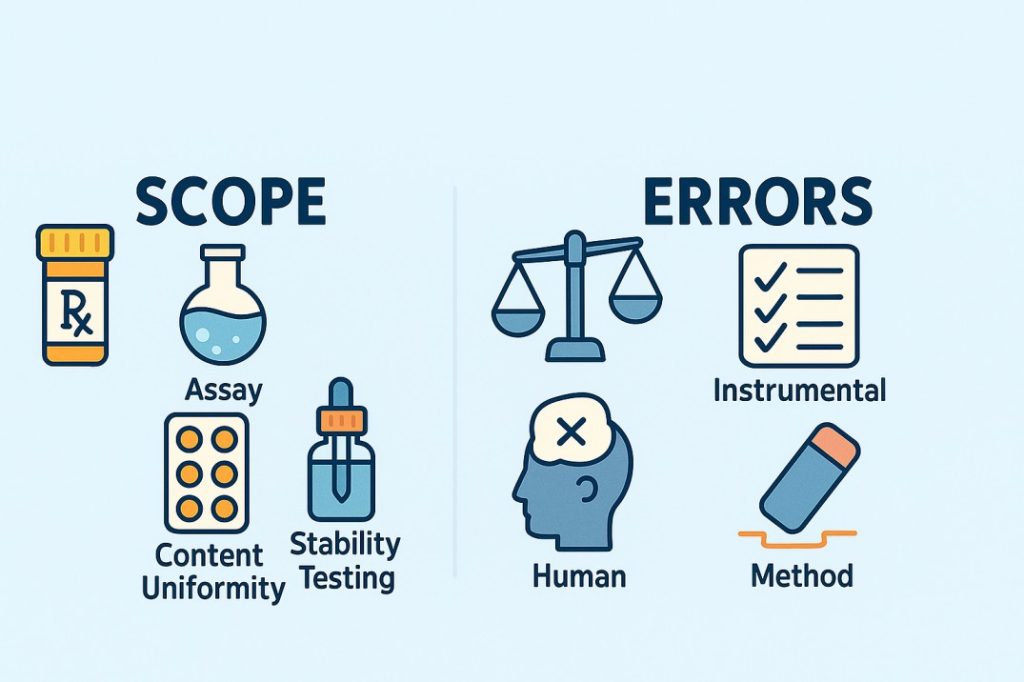Pharmaceutical Analysis I Notes
Unit 1: Definition, scope & Errors
Topics Covered in Unit 1
-
Pharmaceutical Analysis checks drug quality using methods like titration, spectroscopy, and chromatography.
-
Concentration is expressed as
-
Standards are of two types: primary (pure) and secondary (need standardization).
-
Solutions like HCl, NaOH, KMnO₄ are prepared and standardized for accurate use.
-
Errors can be human, instrumental, or environmental in origin.
-
Accuracy means closeness to true value; precision means consistent results.
-
Significant figures show how precise and accurate a measurement is.
-
Pharmacopoeia defines drug standards; impurities are controlled by limit tests.
Unit 2: Acid Base & Non- Aqueous Titration
Topics Covered in Unit 2
-
Indicators show color change in titrations; work by acid-base theory.
-
Titrations are classified by strength of acids and bases: strong, weak, very weak.
-
Neutralization curves help understand pH change during titration.
-
Strong acid–strong base gives sharp pH change near equivalence point.
-
Weak acid–strong base shows gradual pH rise and a buffer region.
-
Very weak acids/bases need special care due to unclear endpoints.
-
Non-aqueous titrations use solvents like glacial acetic acid, not water.
-
Sodium benzoate and Ephedrine HCl are estimated using acidimetry/alkalimetry.
Unit 3: Precipitation & Complexometric Titration, Gravimetry Analysis
Topics Covered in Unit 3
-
Mohr’s, Volhard’s, Fajans methods are used in precipitation titrations.
-
Sodium chloride is estimated using Mohr’s or Volhard’s method.
-
Complexometric titrations use chelating agents to bind metal ions.
-
Indicators for metal ions show endpoint by color change in complexation.
-
Masking/demasking agents hide or reveal ions in complexometric titrations.
-
Magnesium sulphate and calcium gluconate are estimated by EDTA titration.
-
Gravimetry involves weighing a pure, dry precipitate to estimate content.
-
Purity issues include co-precipitation and post-precipitation, e.g., barium sulphate estimation.
Unit 4: Redox titrations
Topics Covered in Unit 4
-
Oxidation is loss of electrons; reduction is gain of electrons.
-
Redox titrations involve transfer of electrons between reactants.
-
Cerimetry uses ceric salts as oxidizing agents in titrations.
-
Iodimetry uses iodine as a direct oxidizing agent.
-
Iodometry uses iodine indirectly, released from iodide.
-
Bromatometry uses bromate as oxidizing agent in presence of acid.
-
Dichrometry uses potassium dichromate to oxidize reducing agents.
-
Potassium iodate is used to titrate analytes via iodine liberation.
Unit 5: Electrochemical methods of analysis
Topics Covered in Unit 5
-
Conductometry measures conductivity to monitor titrations and reactions.
-
Conductivity cell contains electrodes to measure solution conductance.
-
Conductometric titrations help find endpoints without indicators.
-
Potentiometry uses voltage change to detect titration endpoints.
-
Reference electrodes include hydrogen, calomel, and silver chloride.
-
Indicator electrodes like glass and metal detect ion activity.
-
Polarography measures current vs. voltage using electrochemical cells.
-
Dropping mercury and rotating platinum electrodes are used in analysis.
Other Subjects & Units of B Pharmacy 1st Semester
Why Choose Our Pharmaceutical Analysis I Notes?
- Structured Content: Each unit is organized for clarity and ease of understanding.
- Exam-Oriented: Focuses on key topics essential for academic and competitive exams.
- Accessible Resources: Includes external links to authoritative sources for expanded learning.
- Comprehensive Coverage: Addresses all units as per the latest syllabus guidelines.Mohanlal Sukhadia University+5ResearchGate+5pci.nic.in+5
In conclusion, these Pharmaceutical Analysis I notes are designed to provide a solid foundation for your studies. By integrating concise summaries with external resources, you can enhance your understanding and perform confidently in your examinations.
Thank you for reading from Firsthope's notes, don't forget to check YouTube videos!








